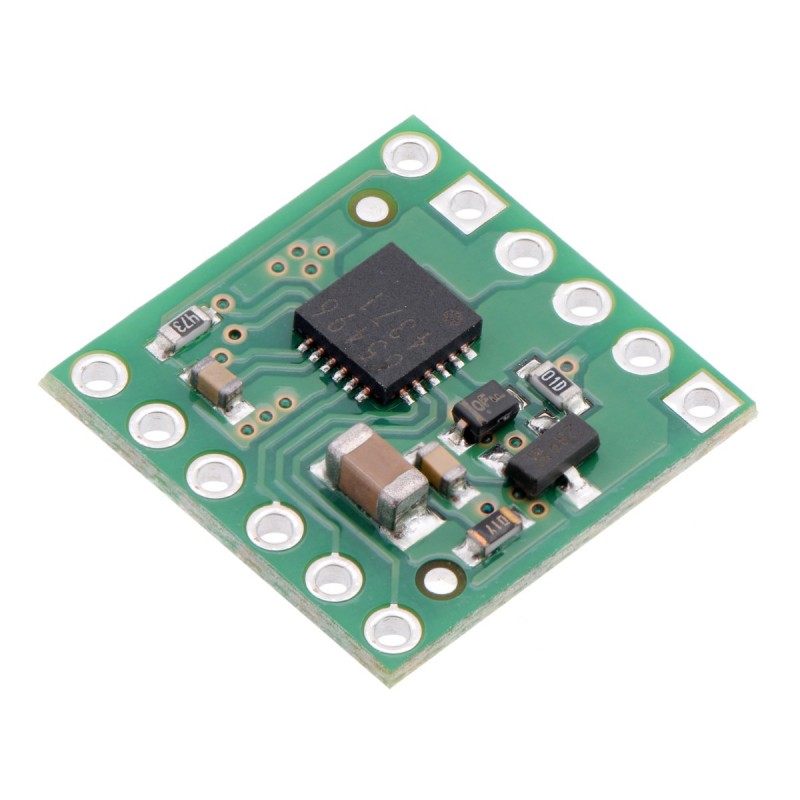







Pololu - 2960
This compact breakout board is for ROHM’s BD65496MUV motor driver, which offers an operating voltage range of 2 V to 16 V and can deliver a continuous 1.2 A (5 A peak for a few milliseconds) to a single brushed DC motor. The motor driver features variable switching speed, allowing for PWM frequencies up to 500 kHz, two drive mode options, and built-in under-voltage and over-temperature protection; our carrier also adds reverse-voltage protection.
DESCRIPTION
Overview
The BD65496MUV from ROHM is a tiny H-bridge motor driver IC that can be used for bidirectional control of one brushed DC motor at 2 V to 16 V. It can supply up to about 1.2 A continuously and can tolerate peak currents up to 5 A for a few milliseconds. The BD65496MUV is a great IC, but its small surface-mount package makes it difficult for the typical student or hobbyist to use; our breakout board makes it easy to use with standard solderless breadboards and 0.1″ perfboards. Since this board is a carrier for the BD65496MUV, we recommend careful reading of the BD65496MUV datasheet (481k pdf). The board ships populated with SMD components, including the BD65496MUV and a reverse battery protection circuit.
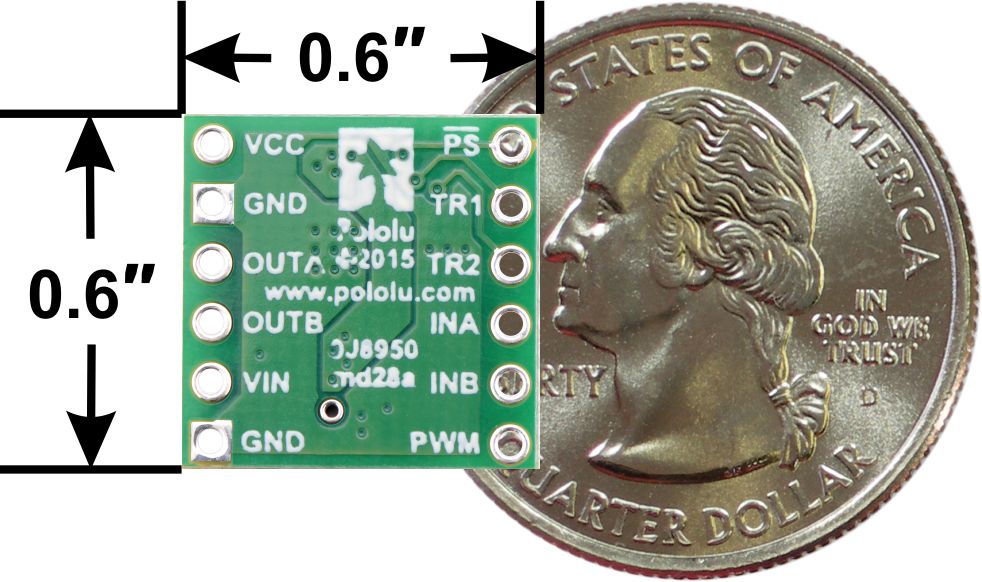
BD65496MUV Single Brushed DC Motor Driver Carrier,
bottom view with dimensions.
Features
Included hardware
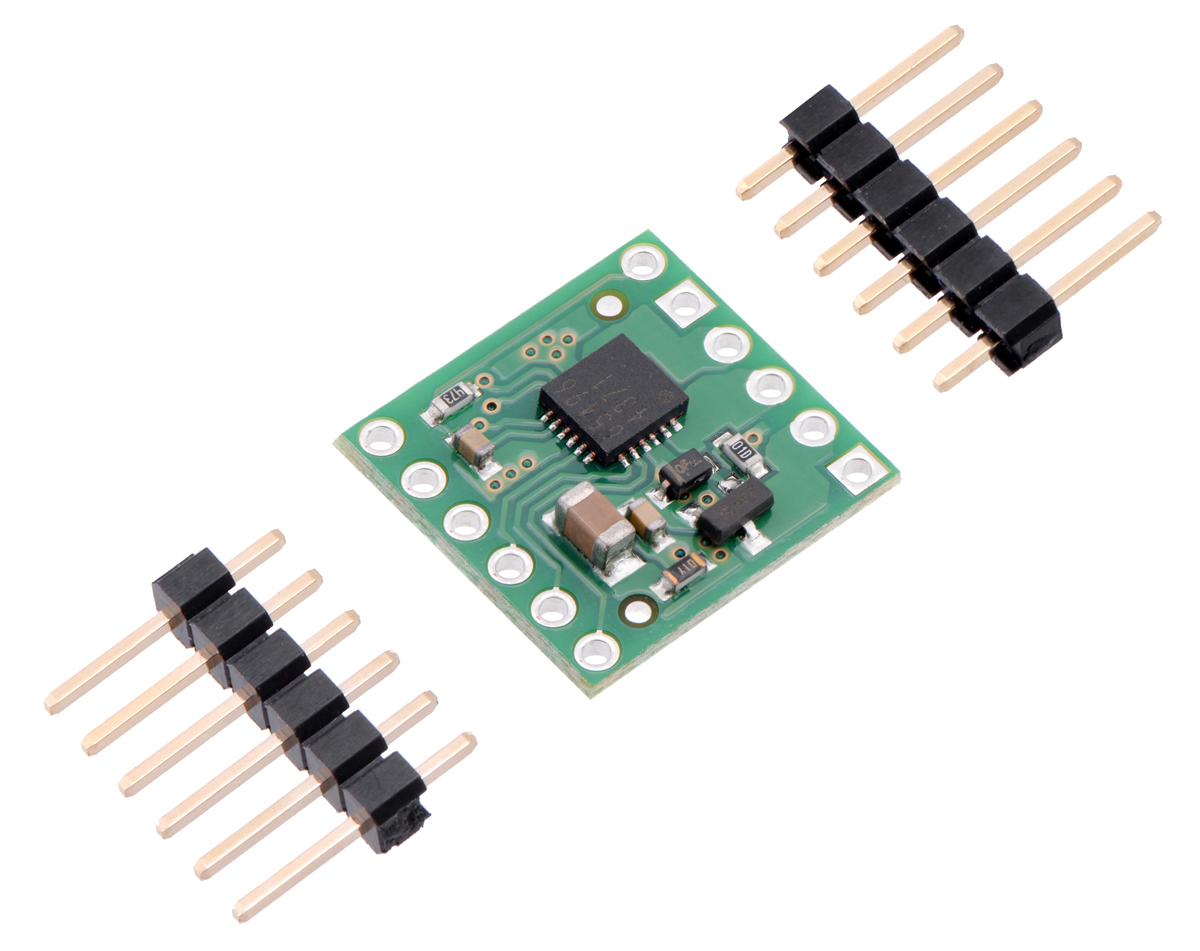

Two 1×6-pin breakaway 0.1″ male headers are included with the BD65496MUV motor driver carrier, which can be soldered in to use the driver with breadboards, perfboards, or 0.1″ female connectors. (The headers might ship as a single 1×12 piece that can be broken in half.) The right picture above shows the two possible board orientations when used with these header pins (parts visible or silkscreen visible). You can also solder your motor leads and other connections directly to the board.
Using the motor driver
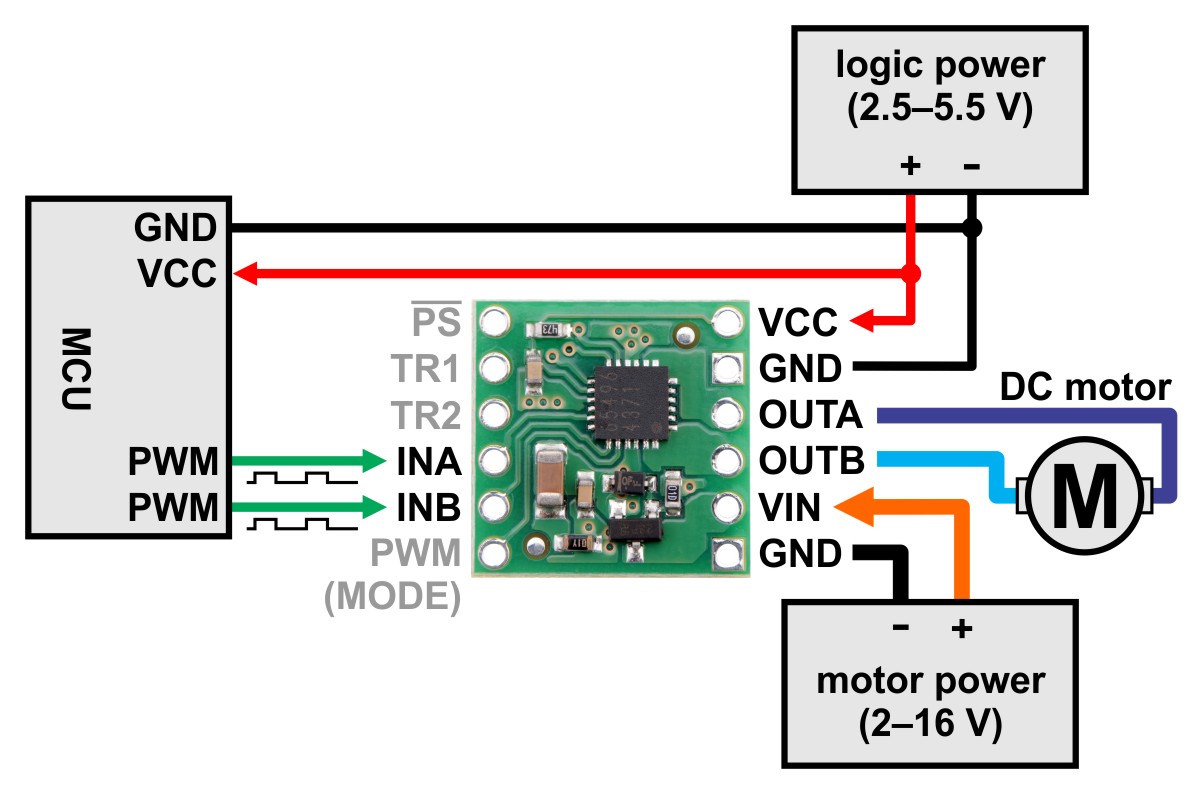
Minimal wiring diagram for connecting a microcontroller
to a BD65496MUV Single Brushed DC Motor Driver Carrier
(default IN/IN mode).
Motor and power connections are made on one side of the board and control connections are made on the other. The driver requires an operating voltage between 2 V and 16 V to be supplied to the reverse-protected power input, VIN, and a logic voltage between 2.5 V and 5.5 V to be supplied to the VCC pin; the logic voltage can typically be supplied by or shared with the controlling device.
The BD65496MUV offers two possible control interface modes: IN/IN and EN/IN. The PWM (MODE) pin is used to select the control interface. If the PWM (MODE) pin is left disconnected or driven low, as shown in the minimal wiring diagram above, the selected interface is IN/IN, which generally requires two PWM signals, one for INA and another for INB. If this pin is driven high, as shown in the wiring diagram below, the selected interface is EN/IN, which turns the INB pin into a “motor direction” input and the INA pin into an enable input that can be supplied with a PWM signal to control speed.

Minimal wiring diagram for connecting a microcontroller
to a BD65496MUV Single Brushed DC Motor Driver Carrier
(EN/IN mode).
The PS (power save) pin can be driven low to put the driver into a low-power state and turn off the motor outputs, which is useful if you want to let the motor coast. The PS pin is pulled high through a 47 kΩ pull-up resistor on the carrier board so that the driver is enabled by default; the quiescent current draw of the board will be dominated by the current through this resistor when the pin is driven low to put the driver to sleep. In most applications, this pin can be left disconnected or can serve primarily as a way to enable coasting. For applications where a low-power mode is desirable, the 47 kΩ pull-up resistor can be removed (this resistor is located right next to the PS pin), or the logic voltage (VCC) for the driver can be dynamically supplied by a digital output of your microcontroller.
The following truth table (taken directly from the BD65496MUV datasheet) shows how the driver operates:
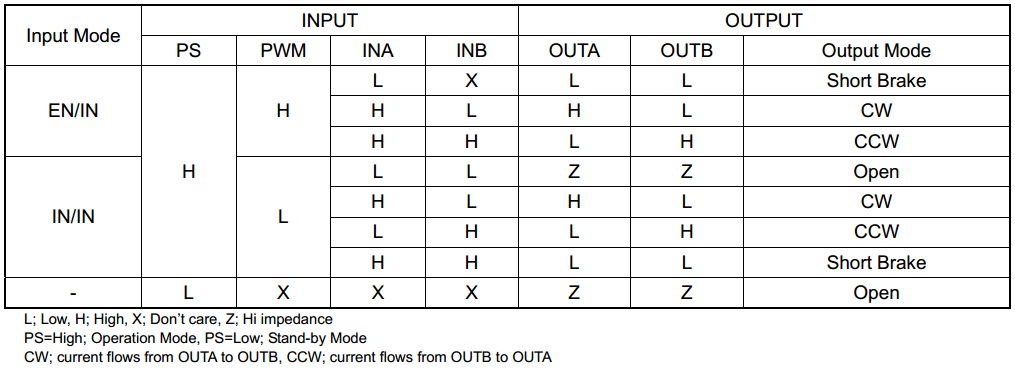
Pinout
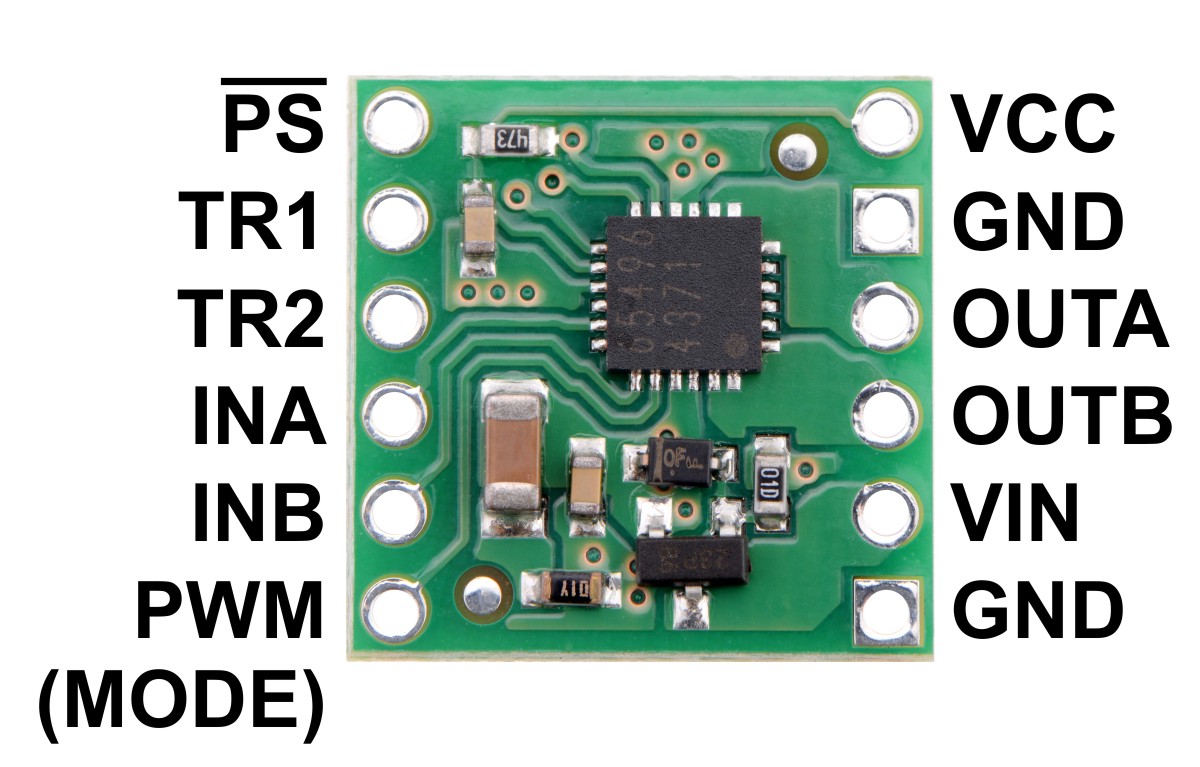
| PIN | Default State | Description |
|---|---|---|
| VIN | Reverse-protected power supply input; supply this pin with 2 V to 16 V. | |
| VCC | 2.5 V to 5.5 V logic power supply connection. Logic supply current draw is typically only a few milliamps at most, so in many applications this pin can optionally be dynamically powered by a microcontroller digital output. | |
| GND | Ground connection points for the motor and logic supplies. The control source and the motor driver must share a common ground. | |
| OUTA | H-bridge output A. | |
| OUTB | H-bridge output B. | |
| PWM (MODE) | LOW | Drive mode selection pin. LOW=IN/IN; HIGH=EN/IN. |
| INA | LOW | Motor control input A (functions like an enable pin in EN/IN mode). |
| INB | LOW | Motor control input B (functions like a direction pin in EN/IN mode). |
| PS | HIGH | Sleep/coast input. Drive low to tri-state the driver outputs and enable power-save mode. |
| TR1 | LOW | Turn-on and turn-off time selection input 1. |
| TR2 | LOW | Turn-on and turn-off time selection input 2. |
All of the driver inputs except PS are internally pulled low through 100 kΩ pull-down resistors. The PS pin is pulled high on the carrier board through a 47 kΩ pull-up resistor that overpowers the driver IC’s internal 300 kΩ pull-down.
The TR1 and TR2 pins control the driver’s turn-on and turn-off time. Both pins are low by default, resulting in a default turn-on time of 150 ns (typical) and a default turn-off time of 50 ns (typical); this allows for PWM frequencies up to 500 kHz. If such a high switching frequency is not required, the TR1 and TR2 inputs can be configured for longer turn-on and turn-off times to help reduce electromagnetic interference (EMI). See the datasheet for more information.
Real-world power dissipation considerations
The BD65496MUV datasheet rates this driver for a maximum continuous current of 1.2 A. In our tests, we found that the chip was able to deliver 1.2 A comfortably over the full operating voltage range, with the driver temperature only approaching the thermal shut down point at the very low end of the motor supply range. At 9 V in, we did not see the driver’s thermal shutdown activate until we pushed the continuous current past 1.5 A for many minutes, but we generally advise against running so close to the limit that the driver overheats. Our tests were conducted at 100% duty cycle with no forced air flow; PWMing the motor will introduce additional heating proportional to the frequency.
SPECIFICATIONS
Dimensions
| Size: | 0.6″ × 0.6″1 |
|---|---|
| Weight: | 0.6 g1 |
General specifications
| Motor driver: | BD65496MUV |
|---|---|
| Motor channels: | 1 |
| Minimum operating voltage: | 2 V |
| Maximum operating voltage: | 16 V |
| Continuous output current per channel: | 1.2 A |
| Peak output current per channel: | 5 A2 |
| Maximum PWM frequency: | 500 kHz3 |
| Minimum logic voltage: | 2.5 V |
| Maximum logic voltage: | 5.5 V |
| Reverse voltage protection?: | YES |
Notes:
1 Without included hardware.
2 For no longer than 10 ms; duty cycle < 5%.
3 TR1 and TR2 low.
RESOURCES
File downloads
Data sheet
Manufacturer BTC Korporacja sp. z o. o. Lwowska 5 05-120 Legionowo Poland sprzedaz@kamami.pl 22 767 36 20
Responsible person BTC Korporacja sp. z o. o. Lwowska 5 05-120 Legionowo Poland sprzedaz@kamami.pl 22 767 36 20
DC motor driver that allows you to control the movement of three drives using the I2C interface. Plate with connectors for assembly. Pololu 5031
No product available!
A4990 Dual Motor Driver Carrier
ESC RC controller module with FlySky receiver. It allows you to control two motors in two directions and one motor in one direction. Dasmigro 2.4G 7CH
No product available!
DC motor driver module with two channels, dedicated to use in modeling. It can be controlled by an RC transmitter and uses the PPM signal. DFRobot DFR0513
KAmod Motor Driver is an advanced DC motor controller powered by 6-30 V, enabling power regulation using the PWM method and control of the direction of rotation, compatible with analog and PWM signals from various sources, equipped with overload and thermal protections and soft start and stop functions
The expansion module is designed to work with micro:bit. It allows you to control 4 DC motors or two stepper motors and 8 servos. It communicates via the I2C interface. DFRobot DFR0548
Pololu 5345 stepper motor driver based on the A5984 IC, intended for controlling bipolar stepper motors with 5V or 3.3V logic levels, equipped with soldered goldpin headers. Pololu 5345
Compact module for driving two DC motors, 6.5–37 V, continuous current 12 A per channel, peak 70 A, with protections and status indicators. DFRobot DFR0601
Extension board with stepper motor controller based on the STSPIN820 system. Ideally suited for use, among others in 2D / 3D printers, robots, cameras. Pololu 2878
Tic T500 USB Multi-Interface Stepper Motor Controller
Pololu High-Power Motor Driver 36v20 CS
The X-NUCLEO-IHM16M1 motor driver expansion board is based on the STSPIN830 monolithic driver for three-phase brushless motors. It represents an affordable, easy-to-use solution for driving brushless motors in your STM32 Nucleo project, implementing single and three-shunt current sensing
No product available!
Pololu G2 18v25 High Power is a miniature DC motor controller. Driver\'s power supply: 6.5 ... 30V. Current capacity of the module: 25A. The module has protection against back voltage and overvoltage. Pololu 1366
This shield makes it easy to control two high-power DC motors with your Arduino or Arduino-compatible board. Its dual robust VNH5019 motor drivers operate from 5.5 to 24 V and can deliver a continuous 12 A (30 A peak) per motor, or a continuous 24 A (60 A peak) to a single motor connected to both channels. Pololu 2507
No product available!

This compact breakout board is for ROHM’s BD65496MUV motor driver, which offers an operating voltage range of 2 V to 16 V and can deliver a continuous 1.2 A to a single brushed DC motor. Pololu 2960
